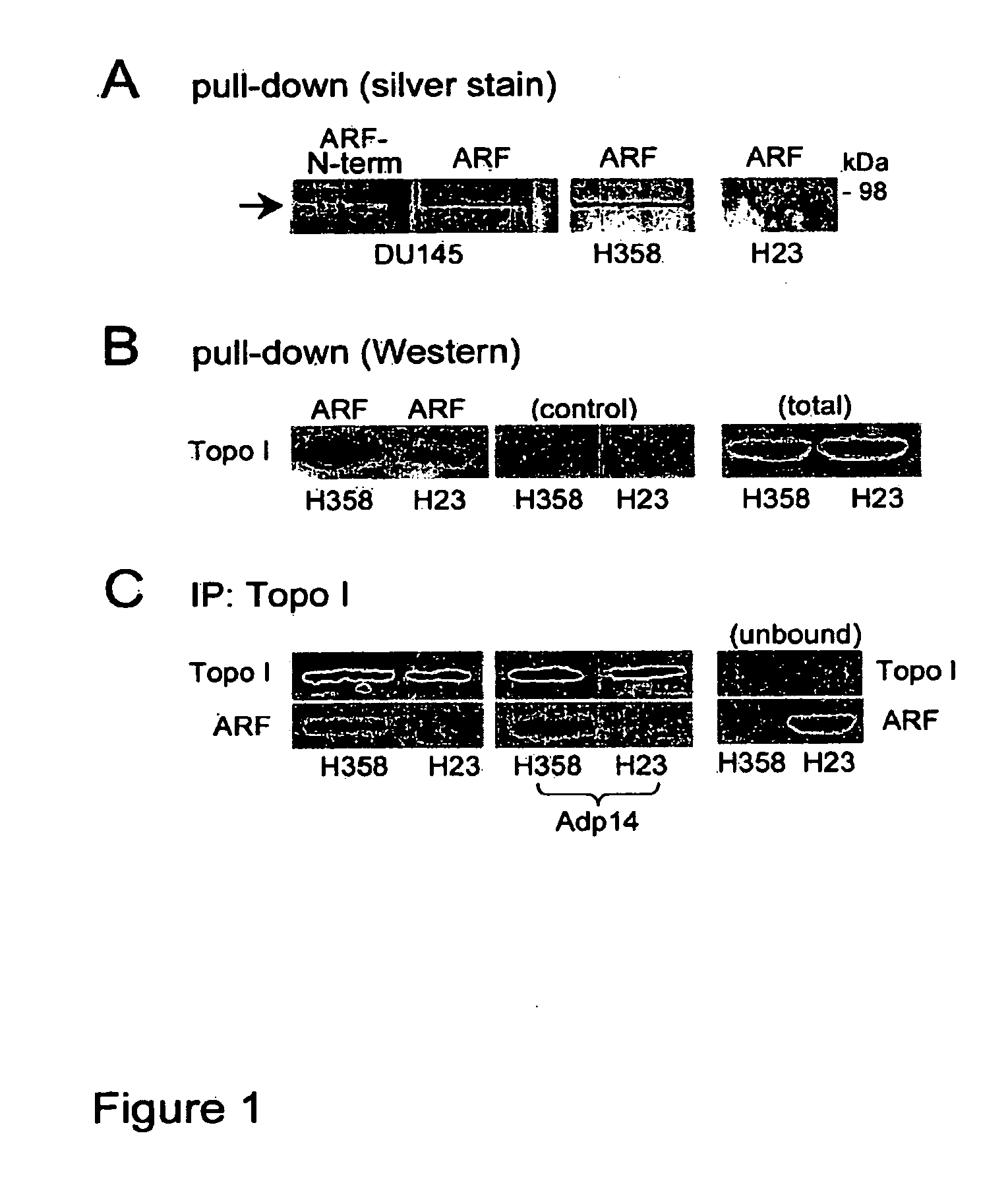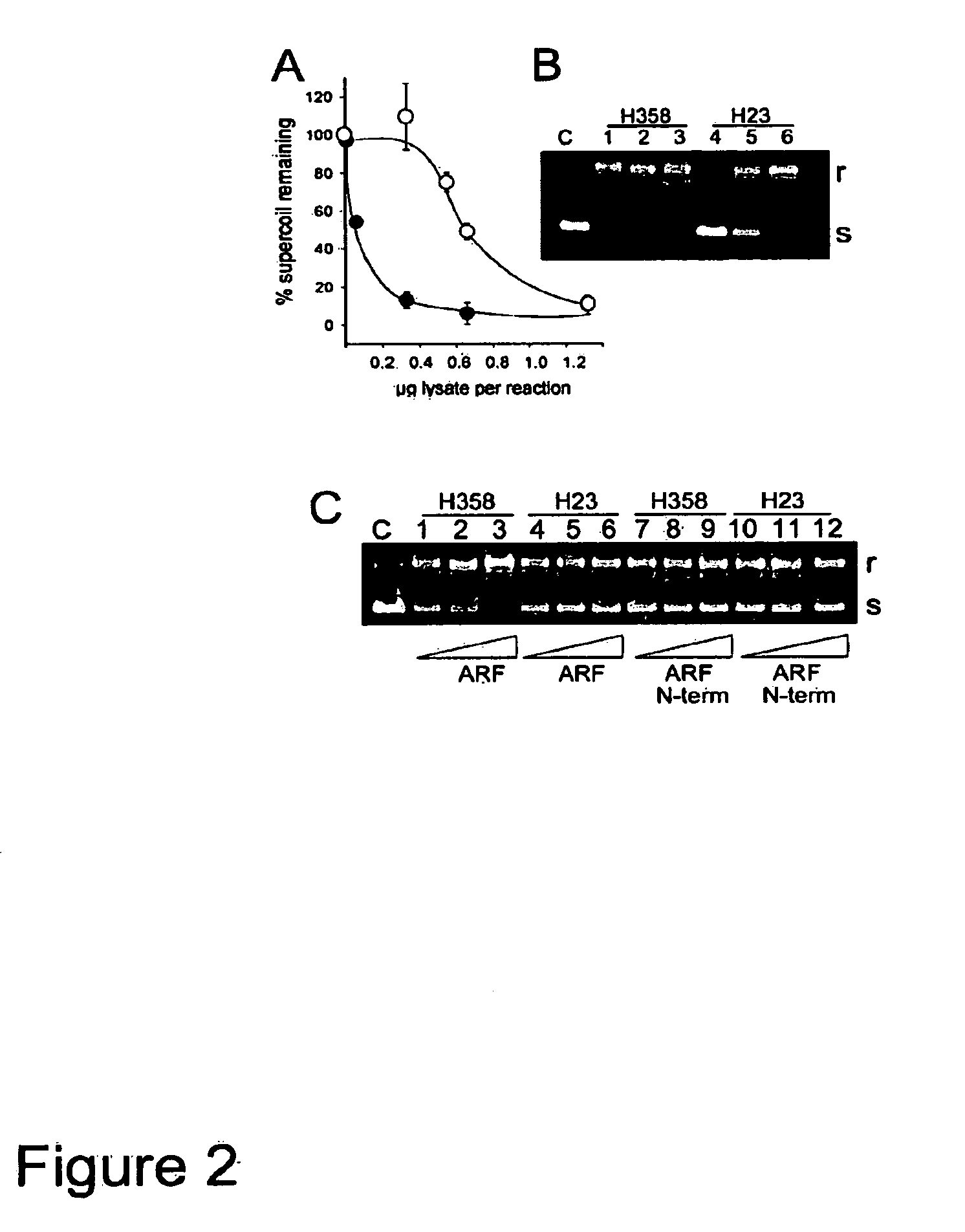Methods and compositions for topoisomerase i modulated tumor suppression
a topoisomerase and tumor suppressor technology, applied in the field of cancer therapy, to achieve the effect of increasing the amount of arf-topoisomerase i complex formation, less sensitive (or insensitive), and reducing the ability of topoisomerase ito bind
- Summary
- Abstract
- Description
- Claims
- Application Information
AI Technical Summary
Benefits of technology
Problems solved by technology
Method used
Image
Examples
example 1
Defective ARF / topoisomerase I Complex Formation in H23 Cells.
[0078]FIG. 1A shows a silver stained gel following a pull-down assay in which immobilized human ARF-thioredoxin fusion protein (or the N-terminal domain (1-64) of ARF) was used to compare ARF-binding proteins from DU145 (prostate cancer), H358, and H23 (non-small cell lung carcinoma)cell RIPA lysates.
[0079]Topoisomerase I bound to full-length ARF (ARF, FIG. 1A) but not the ARF N-terminal domain (ARF-N-term, amino acid residues 1-64, FIG. 1A) encoded by ARF's first exon (exon 1β). This is consistent with previous reports that topoisomerase I binds to ARF through the ARF C-terminal, exon 2-encoded domain (Ayrault, et al., Oncogene 2006;25(19):2827 (correction); Olivier, et al., Oncogene 2003;22(13):1945-54). H23 cells appeared to have significantly less topoisomerase I activity compared to that measured in H358 cells (FIG. 1A, far right lane).
[0080]Western blot analysis confirmed that the level of topoisomerase I was reduced...
example 2
H23 Nuclear Extracts Have Reduced Topoisomerase I Activity Which Cannot be Stimulated by ARF.
[0087]H23 and H358 nuclear extracts were compared for topoisomerase I activity in vitro, and investigated whether the activities could be stimulated by the addition of recombinant thioredoxin-ARF. As shown in FIG. 2A, H358 topoisomerase I was found to be more effective at relaxing supercoiled plasmid DNA than was H23 topoisomerase, achieving 50% relaxation at about 0.06 μg nuclear extract per reaction, some 10-fold lower than the amount of H23 extract needed to achieve the same level of relaxation (0.6 μg extract per reaction). A typical electrophoretic profile of the reaction products with increasing amounts of nuclear extract is shown in FIG. 2B in which 0.32, 0.65, or 1.3 μg of H358 cell extract (lanes 1-3) or H23 (lanes 4-6) were added in each reaction. “r” is the relaxed (non-supercoiled) plasmid and “s” is the supercoiled form.
[0088]Similar assays were carried out using the amount of e...
example 3
Topoisomerase I Activation Requires both Phosphorylation and ARF Binding
[0090]A topoisomerase I immunoprecipitation analysis followed by Western detection of phosphoserine revealed that H358 cells expressed a serine-phosphorylated topoisomerase I (FIG. 3A, lane 1, top row). A similar analysis of phosphotyrosine revealed no evidence for tyrosine phosphorylation (data not shown). Similar results were found in PC-3 cells (data not shown). In contrast, serine-phosphorylated topoisomerase I was only weakly detectable in H23 cells (FIG. 3A, lane 2, top row).
[0091]Treatment of both H358 and H23 nuclear extracts with alkaline phosphatase (AP) eliminated serine phosphorylation (FIG. 3A, lanes 3, 4, top row) and abolished their topoisomerase I activity in vitro (FIG. 3B, lanes 4-6 and lanes 13-15). The dephosphorylated topoisomerase I from H358 cells could no longer be activated by addition of increasing amounts of ARF fusion protein (FIG. 3B, lanes 7-9). Furthermore, while topoisomerase I co...
PUM
| Property | Measurement | Unit |
|---|---|---|
| pH | aaaaa | aaaaa |
| pH | aaaaa | aaaaa |
| pH | aaaaa | aaaaa |
Abstract
Description
Claims
Application Information
 Login to View More
Login to View More - R&D
- Intellectual Property
- Life Sciences
- Materials
- Tech Scout
- Unparalleled Data Quality
- Higher Quality Content
- 60% Fewer Hallucinations
Browse by: Latest US Patents, China's latest patents, Technical Efficacy Thesaurus, Application Domain, Technology Topic, Popular Technical Reports.
© 2025 PatSnap. All rights reserved.Legal|Privacy policy|Modern Slavery Act Transparency Statement|Sitemap|About US| Contact US: help@patsnap.com



